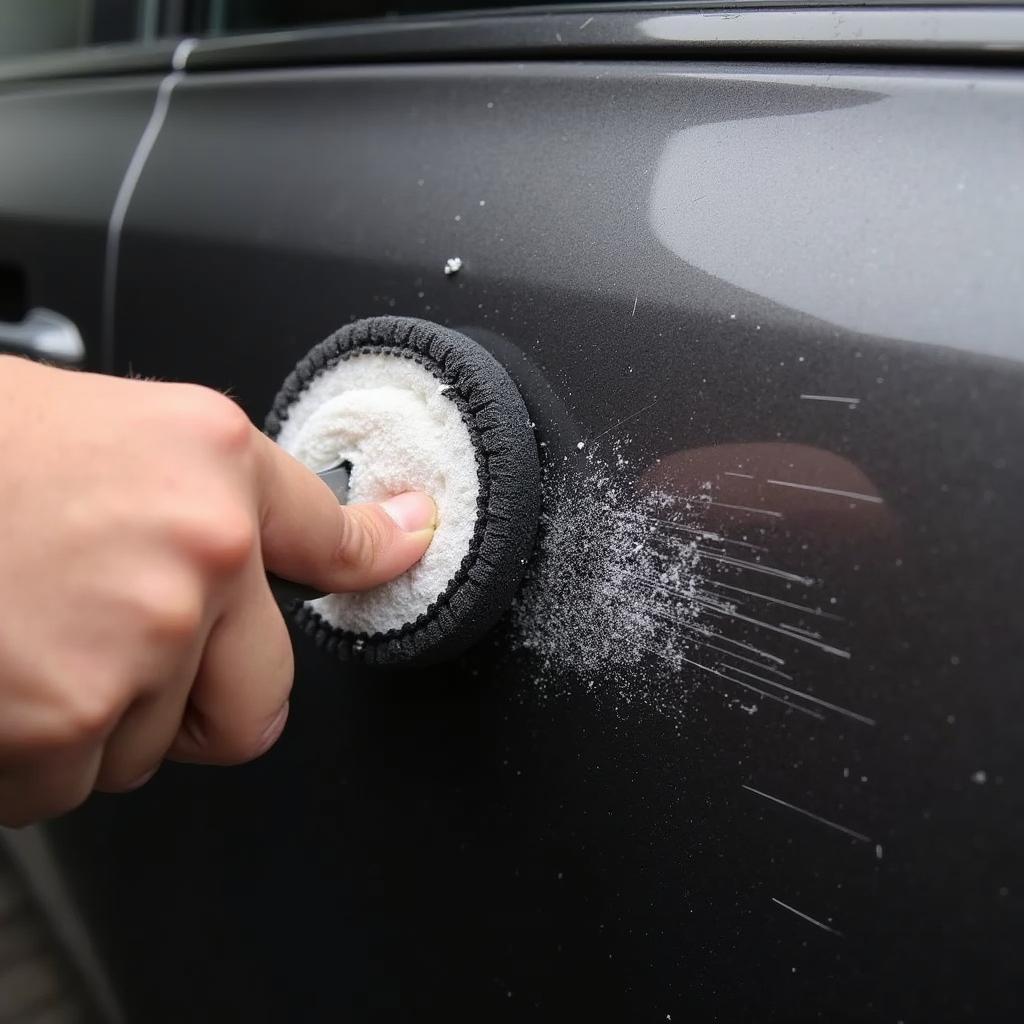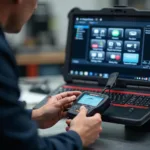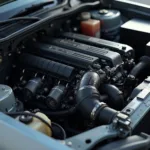Discovering a long, deep scratch etched across your car’s pristine paint job can be incredibly disheartening. This type of damage, often called “keying,” is unfortunately not uncommon and can leave your vehicle looking less than its best. While a trip to a professional body shop might be necessary for severe damage, you can often tackle minor to moderate keyed car paint repair yourself with the right tools and techniques. This comprehensive guide will walk you through the process, helping you restore your car’s finish and erase the evidence of that unsightly scratch.
Assessing the Damage: Is DIY Keyed Car Paint Repair Right for You?
Before you roll up your sleeves and gather your supplies, it’s crucial to assess the severity of the keying damage. This will help you determine if a DIY approach is feasible or if professional intervention is necessary.
- Shallow Scratches: If the scratch only penetrated the clear coat or the very top layer of paint, you’re in luck! These are usually quite manageable with DIY methods.
- Medium-Depth Scratches: Scratches that go slightly deeper, revealing the primer underneath, can still be tackled at home with a bit more effort and patience.
- Deep Scratches: If the scratch is deep enough to expose the bare metal of your car, it’s best to consult a professional. These deep gouges often require more complex repairs like body filler and repainting.
Gathering Your Keyed Car Paint Repair Arsenal
Once you’ve determined that your keyed car is a good candidate for DIY repair, it’s time to round up the necessary tools and materials:
- Car Wash Supplies: A thorough car wash is non-negotiable before you start any repair work.
- Rubbing Compound: This abrasive compound will help smooth out the scratch and remove any loose paint particles.
- Polishing Compound: Follow up the rubbing compound with a polishing compound to restore shine and gloss.
- Microfiber Cloths: You’ll need plenty of clean, soft microfiber cloths for applying and buffing the compounds.
- Masking Tape: Use masking tape to protect the areas surrounding the scratch from accidental compound contact.
- Applicator Pads: These will make applying the rubbing and polishing compounds easier and more even.
- Car Wax: Once the repair is complete, a coat of wax will protect the area and enhance the shine.
How to Repair Keyed Car Paint: A Step-by-Step Guide
Now that you have your supplies ready, let’s dive into the step-by-step process of repairing that keyed car paint:
-
Wash and Dry: Thoroughly wash your car to remove any dirt, grime, or debris that could interfere with the repair. Ensure your car is completely dry before proceeding.
-
Mask the Area: Apply masking tape around the scratch to protect the surrounding paintwork from any accidental damage caused by the rubbing compound.
-
Apply Rubbing Compound: Apply a small amount of rubbing compound to your applicator pad. Work the compound into the scratch using back-and-forth motions, applying gentle pressure.
-
Buff and Inspect: Once you’ve worked the rubbing compound into the scratch, buff the area with a clean microfiber cloth. Check your progress. For deeper scratches, you may need to repeat steps 3 and 4 several times.
 Applying Rubbing Compound to Keyed Car Paint
Applying Rubbing Compound to Keyed Car Paint
-
Polish to Perfection: After the rubbing compound has smoothed out the scratch, apply a polishing compound to another clean applicator pad. Work this into the area using circular motions to restore shine and gloss.
-
Final Buff and Wax: Buff the entire area with a clean microfiber cloth to remove any residue from the polishing compound. Finish by applying a coat of car wax to protect the repaired area and enhance the shine.
Keyed Car Paint Repair Cost: DIY vs. Professional
One of the primary benefits of opting for DIY keyed car paint keyed repair is the cost savings. While professional repairs can range from a few hundred to over a thousand dollars depending on the severity of the damage, DIY repairs can be tackled for the cost of basic supplies.
Here’s a general idea of the cost difference:
- DIY Repair: $20 – $50 (for basic supplies)
- Professional Repair: $100 – $1000+ (depending on severity)
When to Call in the Pros
While this guide provides a comprehensive overview of how to repair a keyed car, there are instances where seeking professional help is advisable:
- Deep Scratches: As mentioned earlier, scratches that expose bare metal often require more complex repairs best handled by experienced professionals.
- Extensive Damage: If the keying damage is widespread or covers a large area of your car, it’s best to leave it to the experts.
- Uncertainty or Lack of Confidence: If you’re unsure about any aspect of the repair process or lack confidence in your DIY skills, err on the side of caution and consult a reputable body shop.
Protecting Your Car from Future Keying Incidents
While repairing keyed car paint is possible, preventing such incidents altogether is always the best course of action. Here are a few tips to safeguard your vehicle:
- Park Strategically: Whenever possible, park in well-lit areas with plenty of space around your car.
- Consider a Car Cover: If you frequently park in areas prone to vandalism, investing in a car cover can provide an extra layer of protection.
- Install a Dashcam: Dashcams can deter potential vandals and provide evidence if your car is damaged.
FAQs About Keyed Car Paint Repair
Can I use toothpaste to repair keyed car paint?
While toothpaste is often touted as a DIY scratch remover, it’s not recommended for keyed car paint repair. Toothpaste lacks the abrasive properties needed to level out a scratch and can leave behind a hazy residue.
How long does it take to repair keyed car paint?
The time required for repair depends on the severity of the damage. Minor scratches can often be addressed in an hour or two, while deeper scratches may require multiple applications of rubbing compound and more time for buffing.
Can I use a hairdryer to speed up the drying time for rubbing compound?
It’s generally not advisable to use a hairdryer on rubbing compound. The high heat can damage your car’s paint and lead to uneven drying. Allow the compound to dry naturally for best results.
Is it worth getting keyed car paint repaired?
Repairing keyed car paint is often worthwhile, especially if the damage is noticeable and detracts from your car’s overall appearance. DIY repairs are cost-effective, while professional repairs can significantly improve your car’s resale value.
Conclusion
A keyed car can be a frustrating experience, but it doesn’t have to mean a hefty repair bill. By following the steps outlined in this guide, you can often repair minor to moderate keyed car paint damage yourself and restore your car’s finish to its former glory. Remember to assess the damage carefully, gather the necessary supplies, and work patiently and methodically for the best results. If you’re unsure about any aspect of the repair process or dealing with severe damage, don’t hesitate to consult a qualified auto body professional.
If you are looking to learn more about the cost of repairing a keyed car, check out our detailed guide on keyed car paint repair cost.
Need help with car keyed repair in Manchester? Visit our page dedicated to car keyed repair Manchester for more information.
For any assistance, feel free to reach out to us via WhatsApp: +1(641)206-8880, Email: cardiagtechworkshop@gmail.com. Our customer support team is available 24/7 to assist you.


